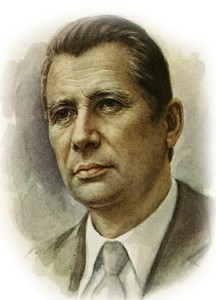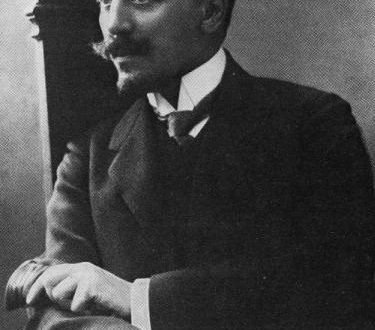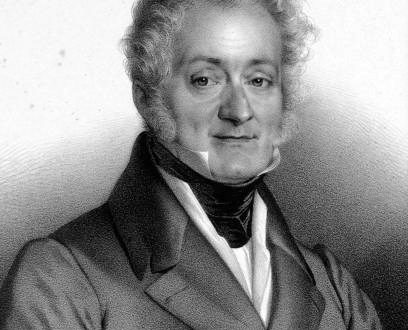
Andrey Yakovlevich Eshpay |
Andrey Eshpay
A single harmony – a changing world … The voice of every nation should sound in the polyphony of the planet, and this is possible if an artist – writer, painter, composer – expresses his thoughts and feelings in his native figurative language. The more national an artist is, the more individual he is. A. Eshpay

In many ways, the artist’s biography itself predetermined a reverent touch to the original in art. The composer’s father, Y. Eshpay, one of the founders of Mari professional music, instilled in his son a love for folk art with his selfless work. According to A. Eshpay, “Father was significant, deep, intelligent and tactful, very modest – a true musician capable of self-denial. A great connoisseur of folklore, he seemed to step aside as an author, seeing his duty in conveying to people the beauty and grandeur of folk thought. He realized that it was impossible to fit the Mari pentatonic scale … to any other harmonious and independent, but alien to folk art system. I can always recognize the original from my father’s work.”
A. Eshpay from childhood absorbed the folklore of different peoples of the Volga region, the entire lyric-epic system of the harsh Ugric region. The war became a special tragic theme in the life and work of the composer – he lost his older brother, whose memory is dedicated to the beautiful song “Muscovites” (“Earring with Malaya Bronna”), friends. In the reconnaissance platoon, Eshpay participated in the liberation of Warsaw, in the Berlin operation. Music lessons interrupted by the war resumed at the Moscow Conservatory, where Eshpay studied composition with N. Rakov, N. Myaskovsky, E. Golubev and piano with V. Sofronitsky. He completed his postgraduate studies under the guidance of A. Khachaturian in 1956.
At this time, Symphonic Dances on Mari Themes (1951), Hungarian Melodies for violin and orchestra (1952), First Piano Concerto (1954, 2nd edition – 1987), First Violin Concerto (1956) were created. These works brought wide fame to the composer, opened the main themes of his work, creatively refracted the precepts of his teachers. It is characteristic that Khachaturian, who instilled in him, according to the composer, a “taste for scale”, largely influenced Eshpai’s ideas about the concert genre.
Especially indicative is the First Violin Concerto with its temperamental explosiveness, freshness, immediacy in the expression of feelings, open appeal to folk and genre vocabulary. Eshpay is also close to Khachaturian with his love for the style of M. Ravel, which was especially pronounced in his piano work (First Piano Concerto, First Piano Sonatina – 1948). Harmony, freshness, emotional contagiousness and coloristic generosity also unite these masters.
The theme of Myaskovsky is a special part in the work of Eshpay. Ethical positions, the very image of an outstanding Soviet musician, a true keeper and reformer of tradition, turned out to be an ideal for his follower. The composer remains faithful to Myaskovsky’s precept: “to be sincere, ardent towards art and lead one’s own line.” Memorial works in memory of Myaskovsky are associated with the name of the teacher: Organ Passacaglia (1950), Variations for Orchestra on a Theme of Myaskovsky’s Sixteenth Symphony (1966), Second Violin Concerto (1977), Viola Concerto (1987-88), in which the material of the organ Passacaglia was used. Myaskovsky’s influence on Eshpay’s attitude to folklore was very significant: following his teacher, the composer came to a symbolic interpretation of folk songs, to the convergence of different traditional layers in culture. The name of Myaskovsky is also associated with an appeal to another most important tradition for Eshpay, which is repeated in many compositions, starting with the ballet “Circle” (“Remember!” – 1979), – Znamenny singing. First of all, in the Fourth (1980), Fifth (1986), Sixth (“Liturgical” Symphony (1988), Choral Concerto (1988) it personifies, first of all, the harmonious, enlightened, ethos principle, the original properties of national self-consciousness, the fundamental principles of Russian culture. Special significance acquires another important theme in Eshpay’s work – lyrical.Rooted in the traditional, it never turns into individualistic arbitrariness, its inalienable qualities are emphasized restraint and rigor, objectivity in expression, and often a direct connection with civic intonations.
The solution of the military theme, the genres of the memorial, the appeal to turning events – whether it be war, historical memorable dates – is peculiar, and lyrics are always present in their comprehension. Such works as the First (1959), Second (1962) symphonies, imbued with light (the epigraph of the First – the words of V. Mayakovsky “We must wrest joy from the coming days”, the epigraph of the Second – “Praise to the light”), the cantata “Lenin with us” ( 1968), which is notable for its poster-like catchiness, rhetorical brightness in expression and at the same time the finest lyrical landscape, laid the foundations for an original stylistic fusion of oratorical and lyrical, objective and personal, significant for the major works of the composer. The unity of “weeping and glory, pity and praise” (D. Likhachev), so significant for ancient Russian culture, is continued in different genres. Particularly prominent are the Third Symphony (In Memory of My Father, 1964), the Second Violin and Viola Concerto, a kind of large cycle – the Fourth, Fifth and Sixth Symphonies, the choral Concerto. Over the years, the meaning of the lyrical theme acquires symbolic and philosophical overtones, more and more purification from everything external, subjective-superficial, the memorial is clothed in the form of a parable. It is significant to switch the lyrical theme from the fairytale-folklore and romantic-heroic narration in the ballet Angara (1975) to the generalized imagery of the warning ballet Circle (Remember!). The universal significance of works-dedications imbued with a tragic, sometimes mournful meaning is becoming more and more obvious. The heightened perception of the conflict nature of the modern world and the sensitivity of the artistic reaction to this quality are consistent with the composer’s responsibility to heritage and culture. The quintessence of imagery is “Songs of the Mountain and Meadow Mari” (1983). This composition, along with the Concerto for oboe and orchestra (1982), was awarded the Lenin Prize.
Objective-lyrical intonation and “choral” sound color the interpretation of the concert genre, which embodies the individual principle. Expressed in various forms – a memorial, a meditative action, in the recreation of folklore, in an appeal to a rethought model of an old concerto grosso, this theme is consistently defended by the composer. At the same time, in the concert genre, as in other compositions, the composer develops playful motifs, festivity, theatricality, lightness of color, and the courageous energy of rhythm. This is especially noticeable in the Concerto for Orchestra (1966), Second Piano (1972), Oboe (1982) Concertos, and the Concerto for Saxophone (1985-86) can be called a “portrait of improvisation”. “One harmony – a changing world” – these words from the ballet “Circle” could serve as an epigraph to the master’s work. The transfer of harmonious, festive in a conflict and complicated world is specific to the composer.
Simultaneously with the embodiment of the theme of traditions, Eshpay invariably turns to the new and the unknown. The organic combination of the traditional and the innovative is inherent both in the views on the composing process and in the composer’s work itself. The breadth and freedom in understanding creative tasks are reflected in the very approach to genre material. It is known that the jazz theme and vocabulary occupy a special place in the composer’s work. Jazz for him is in some way the custodian of music itself, as well as folklore. The composer paid much attention to the mass song and its problems, light music, film art, which is important in terms of dramatic and expressive potential, a source of independent ideas. The world of music and living reality appear in an organic relationship: according to the composer, “the wonderful world of music is not closed, not isolated, but is only a part of the universe, whose name is life.”
M. Lobanova





